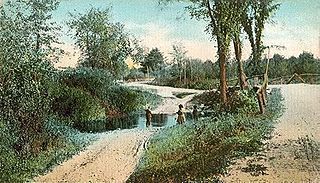
Barrington is a town in Strafford County, New Hampshire, United States. The population was 9,326 at the 2020 census, up from 8,576 at the 2010 census. The town is a woodland, farm and commuter town.
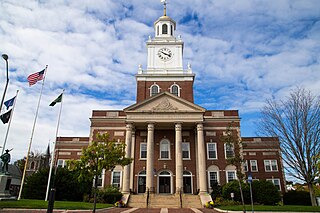
Dover is a city in Strafford County, New Hampshire, United States. The population was 32,741 at the 2020 census, making it the largest city in the New Hampshire Seacoast region and the fifth largest municipality in the state. It is the county seat of Strafford County, and home to Wentworth-Douglass Hospital, the Woodman Institute Museum, and the Children's Museum of New Hampshire.

Durham is a town in Strafford County, New Hampshire, United States. The population was 15,490 at the 2020 census, up from 14,638 at the 2010 census. Durham is home to the University of New Hampshire.
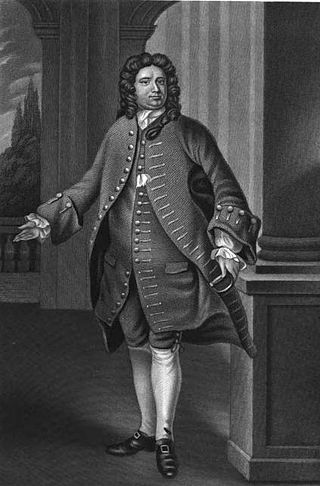
John Wentworth was an American sea captain, merchant, judge, politician and colonial administrator who served as the lieutenant governor of New Hampshire from 1717 to 1730.

John Charles Waldron was a United States Navy aviator who led a squadron of torpedo bombers in World War II. He was among the twenty-nine men in his squadron who perished in the Battle of Midway.

The Cochecho River is a tributary of the Piscataqua River, 38.3 miles (61.6 km) long, in the U.S. state of New Hampshire. It rises in northern Strafford County and runs southeastward, through the town of Farmington and the cities of Rochester and Dover, where it provides hydroelectric power. Below the center of Dover, the river is tidal and joins the Salmon Falls River at the Maine border to form the Piscataqua. Significant tributaries include the Ela River, the Mad River, and the Isinglass River.

John Cutt was the first president of the Province of New Hampshire.
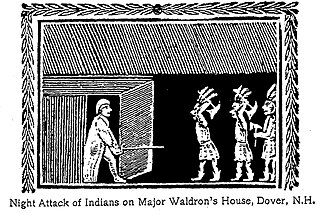
Major Richard Waldron was an English-born merchant, soldier, and government official who rose to prominence in early colonial Dover, New Hampshire. His presence spread to greater New Hampshire and neighboring Massachusetts. He was the second president of the colonial New Hampshire Royal Council after it was first separated from Massachusetts.

Colonel Thomas Westbrook (1675–1743/44) was a senior New England militia officer in Maine during Father Rale's War. In addition to this senior militia role he was a scout, a colonial councillor, an innkeeper, a mill owner, a land speculator and a King's Mast Agent. He is the namesake of Westbrook, Maine.

Richard Russell Waldron was a purser "and special agent" in the Wilkes Expedition, together with younger brother Thomas Westbrook Waldron (consul). Several landmarks were named after him or his brother. After the expedition was completed Waldron enjoyed some popularity and influence in Washington, D.C.
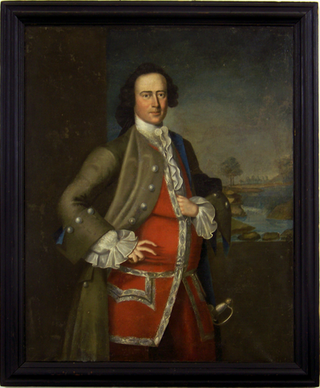
Thomas Westbrook Waldron was a prominent political figure in Dover, New Hampshire, and a military officer that fought in the Siege of Louisbourg of 1745. He later became a commissioner at Albany, New York, and then a royal councillor in 1782. During the American Revolution, Waldron abandoned his loyalist friend, British colonial governor of New Hampshire John Wentworth, to become a patriot of the United States.

Thomas Westbrook Waldron was a captain's clerk on the Wilkes Expedition, and the first United States consul to Hong Kong. His service to the United States consular service was honoured by Secretary of State Hillary Clinton during a ceremony in 2009.

Richard Waldron (1694–1753) was a major opponent of the Wentworth oligarchy in colonial New Hampshire. He supported a continued political subordination of New Hampshire to Massachusetts and opposed moves to separation from this traditional senior partner. Through his friendship with Massachusetts governor and kinsman Jonathan Belcher and his positions of Secretary, Councillor, and New Hampshire assembly speaker, for a time he was "the central authority" in colonial New Hampshire politics.

The Raid on Dover happened in Dover, New Hampshire on June 27–28, 1689. Led by Chief Kancamagus, it began King William's War, a series of Indian massacres orchestrated by Jean-Vincent d'Abbadie de Saint-Castin and Father Louis-Pierre Thury.
Joseph M. Bell was a New Hampshire and Massachusetts lawyer, abolitionist, and politician. Bell served as a member of the New Hampshire House of Representatives in 1821 and from 1828 to 1830 and the Massachusetts House of Representatives from 1845 to 1847. He served as a member of the Massachusetts Senate from 1848 to 1849 and President of the Massachusetts Senate in 1849.

The Cocheco Mills comprise a historic mill complex in the heart of Dover, New Hampshire. The mills occupy a bend in the Cochecho River that has been site of cotton textile manufacturing since at least 1823, when the Dover Manufacturing Company supplanted earlier sawmills and gristmills. The present mill buildings were built between the 1880s and the early 20th century, and were listed on the National Register of Historic Places in 2014.

George G. Adams was an American architect from Lawrence, Massachusetts.

Adelaide Cilley Waldron was an American author and editor of the long nineteenth century. She wrote poems, hymns, sonnets, children's stories, essays, and letters for newspapers, as well as articles for educational and historical journals. Farmington was published in 1904. Waldron was an accomplished musician and a clubwoman. She was associated with the Daughters of the American Revolution, Woman's Christian Temperance Union, New England Woman's Press Association, and other organizations.
Robert Eames was an American miller and political figure who served as Saugus, Massachusetts first representative to the Massachusetts House of Representatives.
















